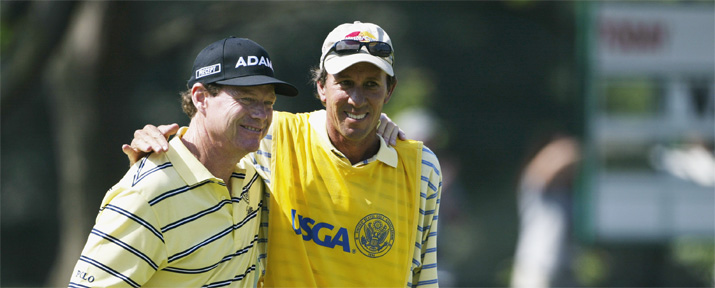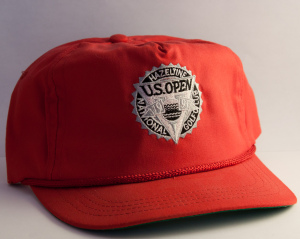Golfing with a caddy is a relatively rare experience in the United States, and I believe a renewed, broad focus on caddies and caddy programs would be immensely beneficial to the game of golf, the golfers themselves, and caddies in many, many ways.
Unless you’re new here, you know I can’t possibly do a short and to-the-point post, so first some exposition on me (focus: me. Good.) Where I grew up, there were no caddies (there were only a couple golf courses.) The first time I caddied was during the 1984 USGA Women’s Amateur Public Links Championship, which needed a significant number of caddies and basically if you could carry a bag you could go out and caddy. I carried for a nice woman from Philadelphia the first two days, but sadly she didn’t make it past stroke play, so I went back into the caddy pool and got on with another player I don’t recall at this point. There may have been two other players during match play for whom I caddied, and both were defeated. Through an odd stroke of luck a friend of mine had drawn Heather Farr as his player at the start of the tournament and, as she kept winning and advanced to the final, my friend had to admit to her that he had another commitment and could not carry her bag on the weekend. Not the optimal situation if you’re a player. He knew I was available, and I shall be forever indebted to him for introducing me to her as his substitute for the weekend (thanks J). It was such joy to watch her hit a golf ball, I didn’t even care if she paid me (she paid me.) She went on to win the tournament and then to the LPGA Tour not long after that. [Her story has a tragic ending, but I am so happy I got to meet her and see her play. Favorite line from her: “My dad always told me, if you can’t play well, at least play fast.” She played very fast. Of course it does help if you only hit the ball 68 times in 18 holes.]
I then caddied in the local mini tour event for a pro from Washington state, and that was when my real education as a caddy began. He had the largest Titleist tour bag I had ever seen, which situation was compounded by his being under the weather and carrying about a gallon of Gatorade and by the course being seriously hilly. I learned a great deal from him about how to take care of a player, what they wanted you to do, where you should stand, and more than I would like to admit, what NOT to do and where NOT to stand. Carrying that bulbous black and white bag and watching him play are some of my fondest memories from that time (thanks JC), not to mention that I skipped a couple days of high school to get the gig (thanks, Mom, for the notes.) I would have done it for free.
After that, I caddied again for the mini tour event, and then did some loops at Hazeltine when I worked there on the grounds (thanks, Doc, for requesting me for that member guest; far better than hand raking all those traps for my regular job.)
The point here is, I had some wonderful experiences, met some great people, had the best seat in the house for some spectacular golf (and even more not-so-spectacular golf), learned a great deal about golf and people, and got to be outside making money, while today high school kids have fewer options than ever for reasonably good summer jobs, golf is dying, and golfers (and Americans in general) are fatter than ever. Let’s bring back the caddy and solve these problems.
As usual here in America, money and laziness created this problem. Clubs and club pros and public courses make money renting out carts, and I don’t think it takes a PhD in math to figure out cart rental money will almost always be greater than caddy program money, since carts are inanimate employees.
Running a caddy program reasonably complicated and detailed, and the revenue, if any, to the course would naturally be lower than from a fleet of carts. Carts don’t no-show on Saturday mornings or otherwise misbehave, don’t have to be managed by a lot of people, and don’t have to be trained. Caddies, on the other hand, do not require intrusive and expensive paved cart paths (which are usually in play, too), barn-like storage and repair facilities, electricity, or fuel, and do not compact the turf all over the entire course every time they leave one of those lovely paved cartways.
Resort designers (and other golf course builders) are also at fault: they build courses that are so convoluted (read: more condos and/or on suboptimal land) the courses REQUIRE you to take a cart and won’t even allow players to walk. I avoid playing at places that do this and have more than once walked out on a reservation. [I fervently hope each of these places has their very own Carl Spackler on staff to “remedy” their “gopher” situations.]
I prefer to walk for many reasons, but one of the main ones is I play better: as I walk up to my ball I have a few moments to assess my predicament, think about possible ways to extricate myself, and formulate a plan, so that when I reach my ball, I can pull a club and hit. With a golf cart, all-too-quickly BAM there I am beside my ball and THEN I have to figure all that out and everybody’s waiting for me and hurry the guys behind are on the tee and the other three players in my group are playing with their ridiculous laser beams and lighting their cigars and texting their mistresses and watching a squirrel so I HAVE TO HURRY and WHOOSH there goes the ball into the woods. I. Hate. That. Many years ago the USGA promoted signing a “Walking Pledge”, and they would send you a “Walking Member” bagtag along with your regular bagtag, the idea being to encourage people to walk more when playing. The one on my bag is the only one I have ever seen.
Now, I have no problem with senior citizens or others taking carts if they are legitimately physically unable to play the game without a cart. At least they’re playing this great game. What I do have a problem with is able-bodied people taking carts. Trust me, you could use the walking, there, chubs.
Let’s be clear: carts DO NOT “speed up” play, they slow it down. Which is faster, walking to the corner store or driving somewhere, finding a parking spot, and then entering the store? Same issue – you have to take care of the stupid little buggy in addition to playing the game. Takes more time. Even worse if you have to stay only on the cart path, or use their “90-degree rule.” Also, there are two players and only one cart: drive to one ball, wait for him/her to assess the situation, pick a club, go through a mental checklist, toss some clippings in the air, play with their laser beam some more, finally play, then drive to the other player’s ball and repeat. In what universe is any of this faster? The only possible place taking a cart “speeds” play is at poorly-designed resort courses where the mileage between greens and tees is the length of an airport runway. I will not patronize such places if I can possibly avoid it and I generally can.
There’s a reason players on Tour walk with caddies, are in fact required to walk: walking was the way the game was intended, and having someone else there with you to carry your bag, clean your club, and overall help you with strategy and yardages and club selection and housekeeping like divot replacement and bunker raking makes the game SO much more pleasurable. It skims off the less-pleasurable parts of the game, the more work-like aspects, and allows the player to focus JUST on the game. If you play with a regular caddy, he or she will also know you and your game better and can help keep your emotions under control, keep you calmer, and tell you jokes to boost your spirits after you made double on the easiest hole on the front. This is, I believe, a significant portion of professional caddy’s job, and why players keep the same caddy employed over such long periods of time (and also why they pay them so much at the highest levels.) Playing with the benefit of a caddy is wonderful and I highly encourage every golfer, if they have never played with a caddy, to splurge at least once when the opportunity presents itself.
This will not be an easy tide to turn, with laziness and money as the hurdles to overcome. If we can somehow structure the idea of caddy programs as a positive, viable, and good cause to support, make it the “right” or, dare I say it, charitable way to play, to be a good citizen, to do something beneficial, it could change the perception of the game as a rich man’s game into something more and better. There are a couple venerable organizations that do support caddying in the U.S., the Western Golf Association (home of the Evans Scholars Foundation) and the Francis Oiumet Scholarship Fund here in my back yard, but we need more focus with a greater geographic and socioeconomic reach to include ALL the courses that could possibly have viable caddy programs.
Local caddy programs, and I’m talking about at courses other than just the fancy private clubs, could employ a great number of teenagers, boys and girls both. If we could raise awareness and garner public support more broadly, so players see that taking a caddy is both a “green” option, so to speak, AND a huge positive for the community and teens as well as a more enjoyable and satisfying way to play the game. If the cost of the loop to the player is, best case, the same price as taking a cart (and worst case not wildly more expensive, say, within 25%, a number I just made up), BUT the player is then seen as being a charitable sort and can then encourage others to choose the better course, that would get the virtuous circle moving in the right direction. And, to my earlier point, the players will discover the joy of playing the game with a caddy, and will want to do it again and again.
Course managers would also have to figure out how to replace the lost revenue from cart rentals, something I don’t have an easy answer for. Golf courses are already immensely expensive to maintain, and public course budgets (and private, too, I imagine) are already stretched fairly thin. About the only way to replace that lost cart rental revenue is via that old chestnut: volume. More players.
By introducing more and more young people to the caddy ranks and the game of golf, you will give many of them this wonderful sickness we all have that makes us want to play this masochistic game. Caddies should, no MUST be permitted to play the courses they work on and at no charge. Including access to practice facilities would be even better. I have worked at courses where caddies and grounds crew were not given even highly-restricted playing privileges. I found that astonishing and incredibly short-sighted, regardless of the exclusivity of the club. Caddies who play the course they work at know the course better, and make better caddies. (Ditto for grounds and pro shop employees.) I’m not saying let them have prime tee times on weekends (or necessarily set tee times at all), but they MUST play the game. This will, over time, result in more golfers (and more greens fees, and more hot dog sales, and club sales, and sweater sales) if not necessarily at the club they work for, at all the other clubs they will play during their lifetimes.
Teens who are caddies learn the game: a game based on honor and manners and individual accountability. They meet people who enjoy and appreciate the game for these very qualities and who have achieved some measure of personal success and can help guide the young caddies, provide introductions, write college reference letters, be supportive of their goals and aspirations both on the course and off.
I don’t give this plan much chance of success, sadly. While golfers are amongst the best people, they do still love to cruise around in their little buggies, and, more importantly, the powers that be want the money and won’t let go of a revenue stream until they’re forced to by the market. Political correctness, ie, making taking a caddy the charitable and “right” thing to do, can be powerful, but that’s a ball that is very large and very heavy and thus very difficult to push up this hill. But it won’t move at all until we start pushing it from somewhere.

























